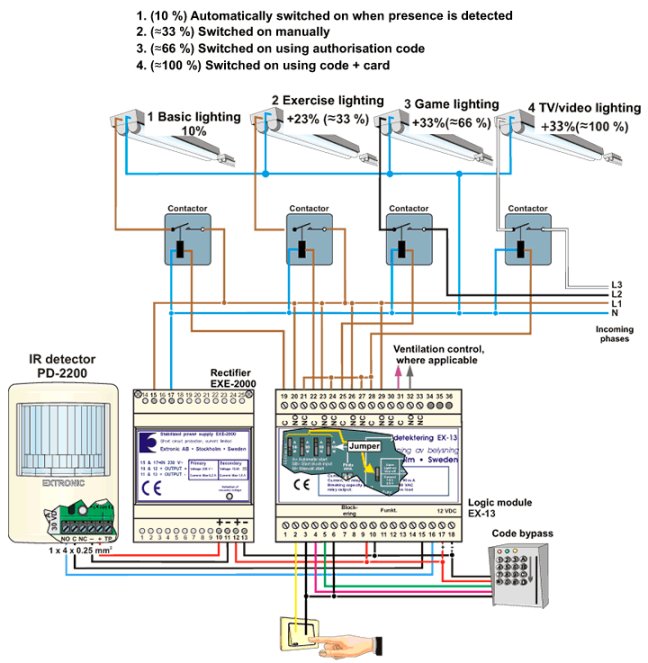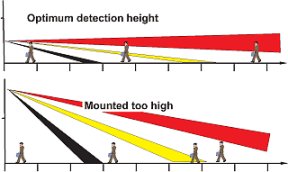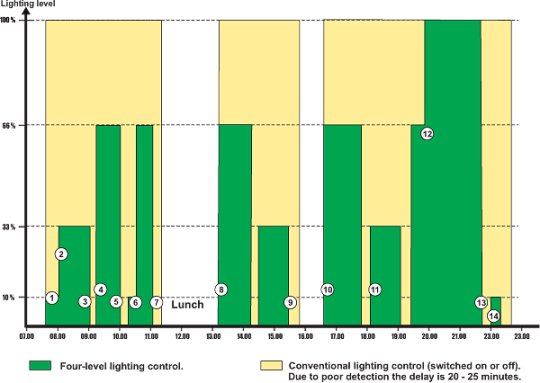5E. Sports hall with IR detectors
50 Hz fittings or non-dimmable HF operating devices, four lighting groups
| The premises
Non-dividable sports hall used for various types of activity.
Light sources
This application shows an example of fittings with 50 Hz choke operation or non-dimmable HF operating devices.
Positioning of detector
Positioning of the detector is crucial to the function! The example below shows how the detector should be positioned. With this positioning optimum detection is achieved upon entry, and the detector does not look out through the entrance, which means the lighting does not remain switched on when someone passes by outside. The detector is positioned in the corner furthest away from the entrance at a height of 2 – 2.5 m. The mounting height is very important to reliable detection. Mounting too high up can result in relatively large areas with poor detection.
A protective grating is used for corner mounting to protect the detector against balls etc.
Control system
Different uses of a sports hall require different light strengths. Thus the possibility of lighting control on four pre-set levels is required. Furthermore, the two upper levels must be blocked to prevent unauthorised activation.
Lighting levels
1. Basic lighting
10 per cent automatic basic lighting will perhaps suffice if the incoming natural light is sufficient for some activities.
|
- Exercise lighting
30 per cent is maybe sufficient for keep-fit and relaxation exercises. Operated using an impulse push-button.
- Game lighting
Some games and competitions will perhaps get by on 70 per cent lighting. It must only be possible for this level to be activated by authorised persons using a code, e.g. when letting out the hall.
- Broadcast lighting
On Saturday, when a premier division handball match is being broadcast on TV, you need full lighting with the right colour temperature. The lighting can only be switched to this setting by the caretaker, by means of a code lock and card reader. When the lighting is switched to the fourth level it switches on all four levels at the same time. There is no need to switch on the lower lighting levels separately and they cannot be switched off separately as long as level 4 is activated.
This suggested solution shows a system in which different light levels are provided by dividing the lighting into sections. Different types of light sources can be used in each section. This application may be an issue if there is no possibility to install dimmable light fittings that enable the light level to be controlled with a dimmer.
The lighting can be switched between four levels by the EX-13 logic module. The outputs from the EX-13 are only intended to operate contactors that are rated for the load or low-level signals. This means that the EX-13 logic module opens up many different possibilities, including the ability to couple ventilation control to the fifth relay output on EX-13. This means that the same presence detector can control both lighting and ventilation. See also the manual for the EX-13 for information on how it can be wired to turn the lighting to full power and stop the ventilation fans, in the event of a fire for instance.
See application 5C if dimmable ballasts are used.
|
 |


|
| Product |
Order No. |
| IR detector PD-2200 |
13140 |
| Rectifier EXE-2000 |
18108 |
| Logic module EX-13 2 ea. |
13164 |
| Code bypass |
19145 |
| Options |
| Protective grating |
13039 |
|

Four-level lighting control in a sports hall
Base lighting = 10 per cent (switched on automatically).
Training lighting +23 per cent, one phase (˜ 33 per cent) (switched on using pushbutton).
Game lighting +33 per cent, two phases (˜ 66 per cent) (switched on using code).
TV/Video lighting +33 per cent all three phases (= 100 per cent) (switched on using code and card).
 |
- The teacher arrives and prepares the hall for the first class: lighting is switched automatically to 10 per cent level.
- The first class starts at 8.00am: an exercise class, for which 33 per cent lighting is sufficient.
- Break: lighting is switched off around 10 minutes after the last person leaves the hall.
- Lighting is switched manually to 66 per cent level when the second class starts (basketball).
- Break: lighting is switched off around 10 minutes after the last person leaves the hall.
- The third class begins with warm-up and the lighting set at 10 per cent, followed by football, during which lighting is increased to 66 per cent level.
- Lunch break: lighting is switched off around 10 minutes after the last person leaves the hall.
|
- Ball game class: lighting is switched manually to 66 per cent.
- Teaching is finished for the day: lighting is switched off around 10 minutes after the last person leaves the hall.
- Indoor bandy team has a training session.
- Aerobics class.
- Basketball league game. During warm-up, lighting is set to 66 per cent, then increased to 100 per cent at start of match.
- Everyone leaves and the lighting is switched off around 10 minutes afterwards.
- Someone returns to collect a forgotten bag. Lighting is switched automatically to 10 per cent then switched off after ten minutes.
|
| The entire yellow area in the diagram above is unnecessary energy consumption that only benefits your electricity supplier! |
Comments are closed.










